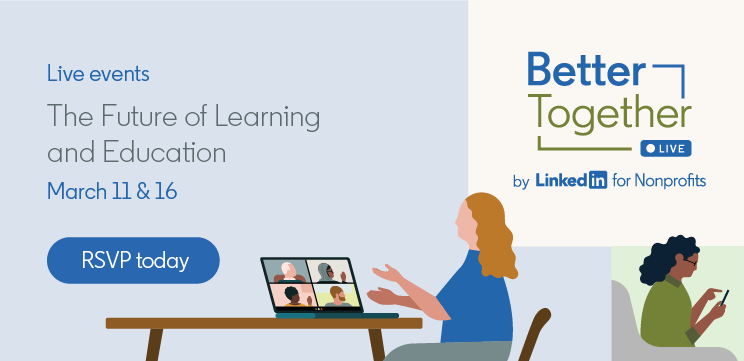
How Nonprofits Can Shape a Learning and Development Program That Works Now and in the Future
COVID-19 has irrevocably changed the world of work. In fact, 74% of learning and development (L&D) professionals say their current focus is on rebuilding or reshaping their organization for the future.
Whether you already have an L&D program or are starting to think seriously about how to ensure your nonprofit has the skills it needs to thrive in an ever-changing landscape, it’s important to shape your program to suit the demands of today—and tomorrow. To help you start designing (or redesigning) your L&D program for the future, here are some insights that Jason Laufer, former Senior Director of LinkedIn Learning and Glint in APAC, Maree Howard, Head of Global Learning at Lendlease, and Ann Ann Low, Senior Director of L&D (APAC) at LinkedIn, shared in a webinar last year.
1. Always scan the environment for signals
With change happening so rapidly, Maree and Ann Ann emphasized the need for L&D to tune into sentiments at the top (as leaders respond to the situation) and on the ground (as learner needs and behaviors change).
“Plans are plans, but if you’re not constantly scanning your environment and shifting your plans accordingly, you’ll miss the boat,” says Maree. For example, when the Lendlease workforce began working from home, Maree observed that many employees were visiting the organization’s COVID-19 microsite every day for updates. The L&D team moved quickly to curate relevant learning content and feature links to them on the microsite. It’s a marketing-inspired move that Maree describes as “going where our learners are.”
Adding on, Ann Ann recommends proactively seeking out employee signals through pulse checks and polls. “We find that learners are now more willing than ever to give feedback. When we allow them to tell us what they need and listen closely to what they’re saying, we can better direct our efforts,” she points out.
2. Experiment with the learning experience
The journey into unchartered territory is one of experimentation and adaptation—or, as Maree puts it, “being comfortable with knowing that we don’t know.” While emerging learning themes such as working and leading remotely, change management, and health and wellness may guide the direction of your program, changes in learning delivery and user experience have to be considered as well.
“We can’t just port classroom training onto an online platform and expect it to work with the same level of effectiveness,” Ann Ann says. To transform instructor-led training into effective virtual learning experiences, she uses several guiding questions:
- How can the content be assembled so that it meets learning objectives while keeping learners engaged?
- Is the content sufficiently modular? Is it too long for online consumption?
- How can group learning be enabled? Should we have formal or informal virtual breakouts?
- How can we motivate learners? Would a dashboard that tracks progress be helpful?
These principles also help address the issue of video fatigue. Maree and Ann Ann suggest “right-sizing” online learning content to match learner attention spans—say, 30 minutes or an hour, depending on what works best at your organization.
3. Tighten the link between L&D efforts and organizational objectives
To achieve leadership buy-in for L&D initiatives, it’s important to demonstrate the value they can bring to your nonprofit. Aligning the learning roadmap with organizational plans is a good way to do this.
“One good indicator of L&D’s impact on [the organization] is how we are building employee capabilities for the future,” says Ann Ann. “This can be quantified by the number of critical roles that can be filled by internal talent because of their learning and development journey, or how L&D is accelerating the leadership succession pipeline.”
For more insights into the future of learning and education at nonprofits and tips to help you shape your L&D strategy, don’t miss our upcoming #BetterTogether live events, including a virtual fireside chat on March 11 with leaders from Teach For America, Girls Who Code, and KIPP Foundation, and an all-new webinar on March 16 led by experts at LinkedIn. Register today, and we hope to see you there!

